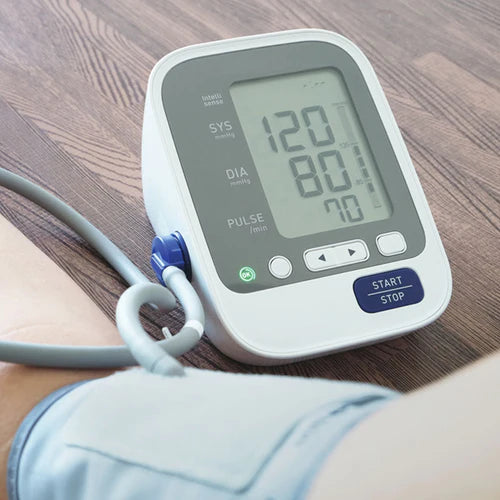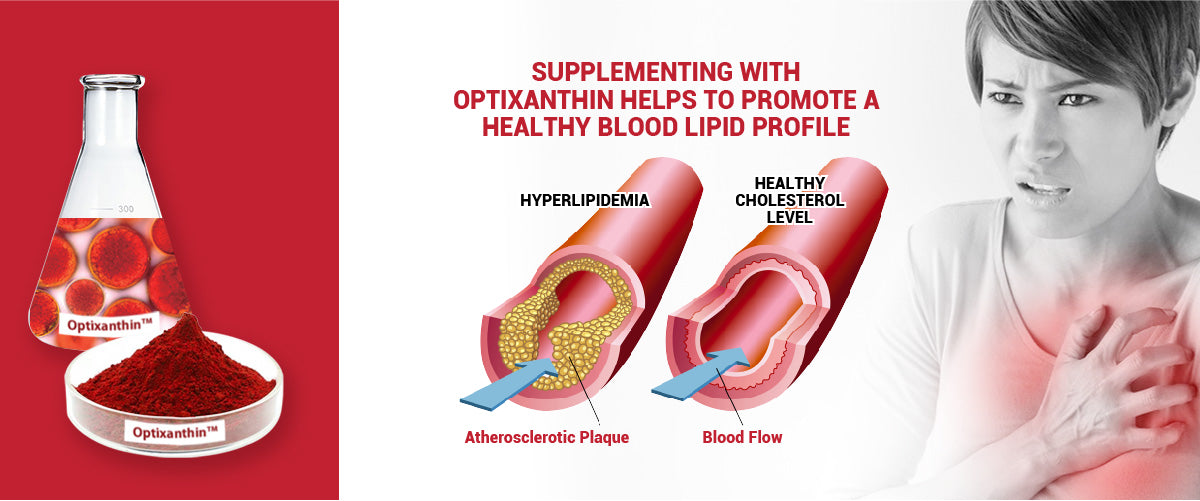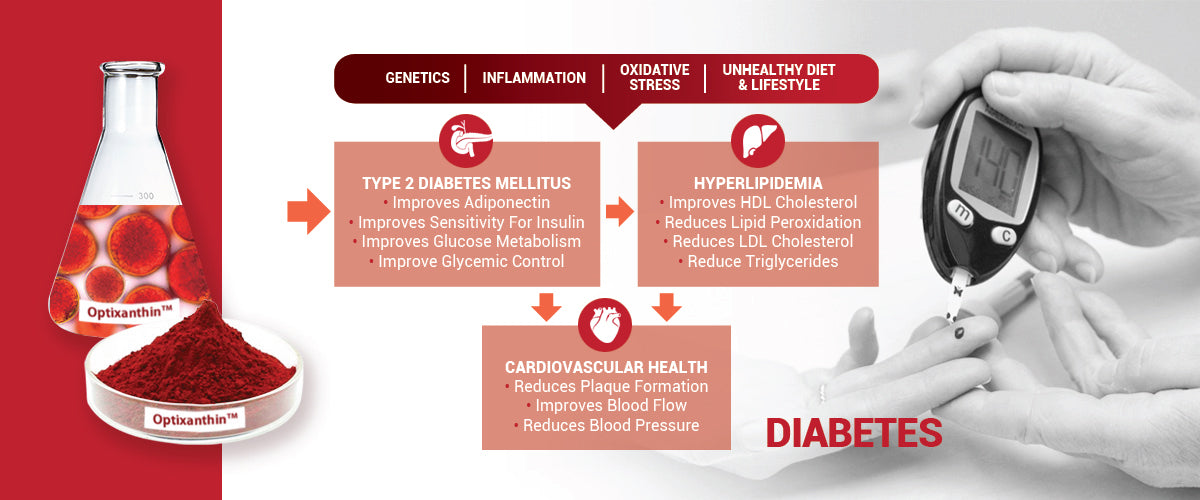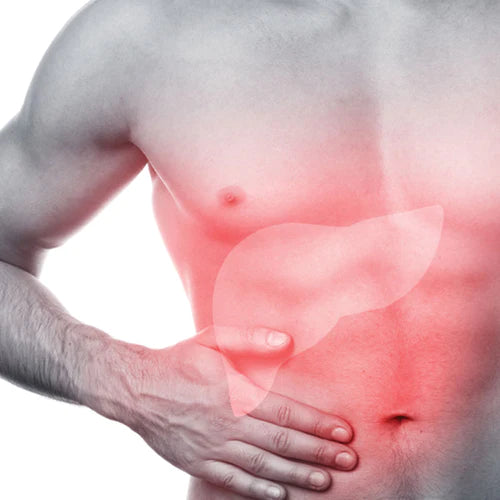Diabetes/Hypertension/Hypercholesterolemia/Heart (Metabolic Syndrome)

Metabolic syndrome
Metabolic syndrome is a cluster of conditions, which includes elevated blood pressure (hypertension), elevated blood glucose (diabetes), elevated triglycerides and low high-density lipoprotein (HDL) levels (hypercholesterolemia)1. These conditions are normally caused by central obesity and physical inactivity, which further increases the risk of cardiovascular diseases (CVD), particularly heart failure.


Malaysia has the highest rate of obesity among Asian countries, with 64% of male and 65% of female population being either obese or overweight2. One of the consequences, the prevalence of diabetes among adults aged 18 years and above would likely to see a worrying trend of 31.3% by 20253.

Type 2 Diabetes
Astaxanthin reduces risks of prediabetes and helps in the management of diabetes

Astaxanthin raises the production of adiponectin (an adipose-specific protein), which stimulates fatty acid oxidation in obese individuals with insulin resistance4, thus a reduction in fasting blood glucose5. Astaxanthin’s antioxidant property helps to protect pancreatic β-cells against oxidative stress induced by high blood glucose levels.

Astaxanthin reduces blood HbA1c and blood glucose levels in prediabetic and type 2 diabetic individuals
Astaxanthin improves serum adiponectin levels, which enhances glucose metabolism and fats utilization
Improvement in glucose metabolism, blood lipid and blood pressure promotes heart health
Astaxanthin improves improved insulin sensitivity, which helps to enhance the breakdown of very low-density lipoprotein (VLDL), and hence further reduces the blood triglycerides levels6.

Astaxanthin improves blood lipid profile and lowers thrombotic risks in type 2 diabetic and prediabetic individuals

Astaxanthin also normalizes blood pressure by reducing the deposition of plaque at blood vessels through modulating the effects on nitric oxide (NO) production. NO helps in regulating the vascular tone and arterial blood pressure7. This overall effect improves the blood chemistry and hence promotes better heart health.

Supporting clinical studies of astaxanthin on blood flow, blood lipids and inflammation marker (CRP)
A study by Fasset on adults with metabolic syndrome showed that astaxanthin supported healthy blood circulation and promoted arterial health8. Human participants supplemented with 6mg of astaxanthin daily for 10 days showed a significant improvement in blood flow9. An animal study featuring rats fed with astaxanthin had decreased hardening of the arteries and the elastin bands in the aorta; and decreased the size of the aerial ratio of coronary arteries10.
Yoshida et al. concluded adults who took astaxanthin had an improved blood lipid profile, namely decreased triglycerides and increased HDL cholesterol. Blood levels of the hormone adiponectin-which promotes insulin sensitivity along with healthy blood sugar and lipid levels, were also higher in those who took astaxanthin. Optimal results were found at 12mg of astaxanthin daily11.
In another double-blind, placebo-controlled study, people who took 12mg of astaxanthin per day for 8 weeks had a 20% decrease in levels of C-reactive protein (CRP), a marker for heart disease and an indicator of systemic inflammation in the body. A 20% reduction in CRP in just 8 weeks is a rather dramatic reduction in disease risk as it indicates reduced risk in heart disease and many other chronic health problems12.
In short, clinical studies revealed that natural astaxanthin helps manage blood glucose levels and lowers risks of diabetes-related complication after 6 to 12 weeks of consumption.
Clinical Benefits of Astaxanthin
✔ Improves blood lipid profile and lowers thrombotic risks in type 2 diabetic and prediabetic individuals
✔ Improves serum adiponectin levels, which enhances glucose metabolism and fats utilization
✔ Reduces oxidative stress caused by glucose toxicity
References:
- Kaplan NM. The deadly quartet: upper body obesity, glucose intolerance, hypertriglyceridemia, and hypertension. Arch Intern Med 1989; 149:1514-20.
- Dr Siti K.A.T., Malaysia and WHO calls for more investment in primary health care the 21st century. WHO. 8 April 2019.
- Dr. Zulkefly A., Malaysia has 3.6 million diabetics. The Star, 27 March 2019.
- Asayama K, Hayashibe H, Dobashi K, Uchida N, Nakane T, Kodera K, Shirahata A, Taniyama M. Decrease in serum adiponectin level due to obesity and visceral fat accumulation in children. Obesity. 2003;11:1072-9. doi: 10.1038/oby.2003.147.
- Weyer C, Funahashi T, Tanaka S, Hotta K, Matsuzawa Y, Pratley RE, Tataranni PA. Hypoadiponectinemia in obesity and type 2 diabetes: close association with insulin resistance and hyperinsulinemia. J Clin Endocrinol Metab. 2001;86:1930-5. doi: 10.1210/jcem.86.5.7463.
- Chan KC et al. 2019. Astaxanthin attenuated thrombotic risk factors in type 2 diabetes patients. Journal of Functional Food (2019); 53:22-27.
- Mashhadi NS et al. 2018. Astaxanthin improves glucose metabolism and reduces blood pressure in patients with diabetes mellitus. (2018); 27(2):341-346.
- Yoshida H, Yanai H, Ito K, Tomono Y, Koikeda T, Tsukahara H, Tada N. Administration of natural astaxanthin increases serum HDL-cholesterol and adiponectin in subjects with mild hyperlipidemia. Atherosclerosis. 2010;209:520-23. doi: 10.1016/j.atherosclerosis.2009.10. 012.
- Yanai H, Ito K, Yoshida H, Tada N. Antihypertensive effects of astaxanthin. Intergrated Blood Pressure Control. 2008:1:1-3.
- Fassett, RG., et al. (2008). “Astaxanthin versus placebo on arterial stiffness, oxidative stress, and inflammation in renal transplant patients: a randomized, controlled trial,” BMC Nephrology. 9:17.
- Miyawaki, H., et al. (2008). “Effects of astaxanthin on human blood rheology,” Journal of Clinical Biochemistry Nutrition. 43(2): 9–74.
- Hussein G1, et al. (2006). “Antihypertensive potential and mechanism of action of astaxanthin: III. Antioxidant and histopathological effects in spontaneously hypertensive rats.” Biological and Pharmaceutical Bulletin. 29(4):684-88.
- Yoshida H., et al. (2010). “Administration of natural astaxanthin increases serum HDL cholesterol and adiponectin in subjects with mild hyperlipidemia,” Atherosclerosis. 209: 520–523.
- Awamoto, T., et al. (2000).“Inhibition of low-density lipoprotein oxidation by astaxanthin,” Journal of Atherosclerosis Thrombosis. 7(4): 216–222.





